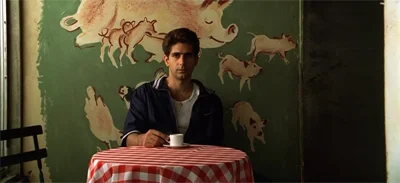Phil Abraham (right) on set of 'The Sopranos.' Image via Tiffen.
Phil Abraham, referenced in an earlier post, is a director and cinematographer, who has worked on 'The Sopranos,' 'Mad Men' and 'Daredevil' (Netflix series).
Here he is on the influence of Gordon Willis and Vilmos Zsigmond, two legendary cinematographers:
"Willis' techniques were popular enough to be ingrained in much of today's modern cinematography[.] [...] He was the first to make large use of bay lights, which are common equipment today. The use of a soft overhead source seemed very appropriate for [']The Godfather,['] rendering the characters in a subdued light and letting their eyes go a little dark. He also introduced the basic philosophy that it is the actors, rather than the camera, that should move, while lighting and composition should take center stage to create mood and drama. On the other hand, I was assistant cameraman to Vilmos Zsigmond while filming the movie 'The Witches of Eastwick,' and he moves the camera and zooms constantly, [...] But he moves it in such a continuous and intuitively fluid way that it is barely noticeable. They are both great cameramen with very different styles, and any new cameraman shooting today will look to them and several others for influence. They are the forerunners of modern cinematography."
The above excerpt is from a great 2000 Tiffen feature detailing Abraham's work on 'The Sopranos.'
Opening shot, "The Legend of Tennessee Moltisanti", from 'The Sopranos' season 2. Image via m0vie blog.
In a fascinating interview from a 2008 issue of the American Cinematographer, Abraham explains his approach to his work on 'Mad Men.' Notice how visual art and contemporary culture (of the time) relate to the choice of production design and shooting style:
From the 'Mad Men' pilot. Image via AV Club.
“Many TV projects rely greatly on close-ups for coverage, and that is not necessarily part of our language. [...] [']Mad Men['] has a somewhat mannered, classic visual style that is influenced more by cinema than TV. [...] We talked about not simply referencing the period as seen in movies of that time. We wanted to be more genuine than that. Movies were an influence, but we didn’t say, ‘Let’s make 'The Apartment.' [...] We noticed that in all the Skidmore, Owings & Merrill designs of contemporary buildings, the ceiling — the overhead grid of lights — was a strong graphic element in all the office spaces. In one design we loved, the whole ceiling was like a lightbox. It was a time of high modernism, and we embraced the notion of presenting the world in that way. These were new work spaces — sleek, not stuffy.”
If you are interested exploring Abraham's work, head over to his filmography on IMDb.
- JG



